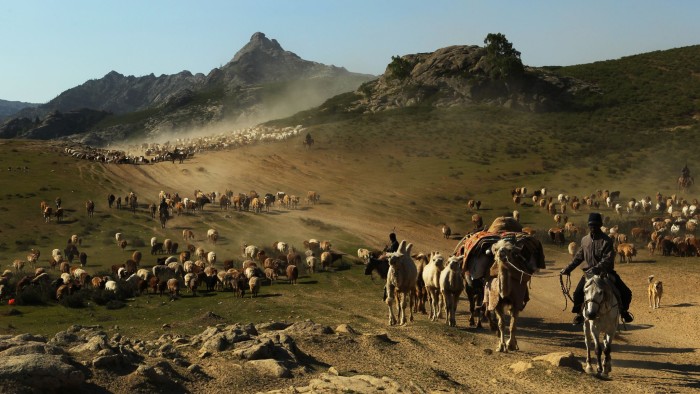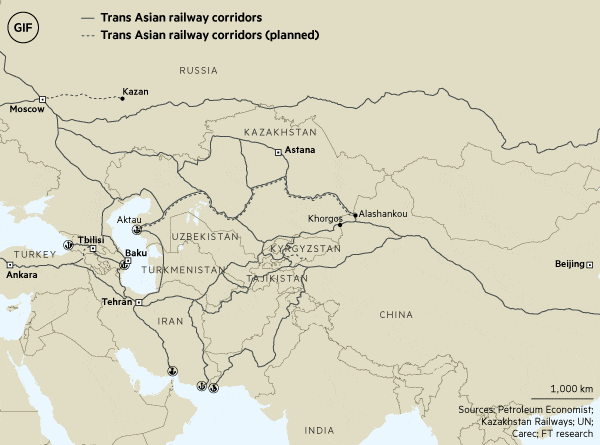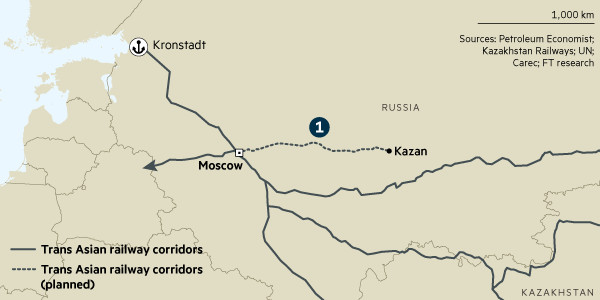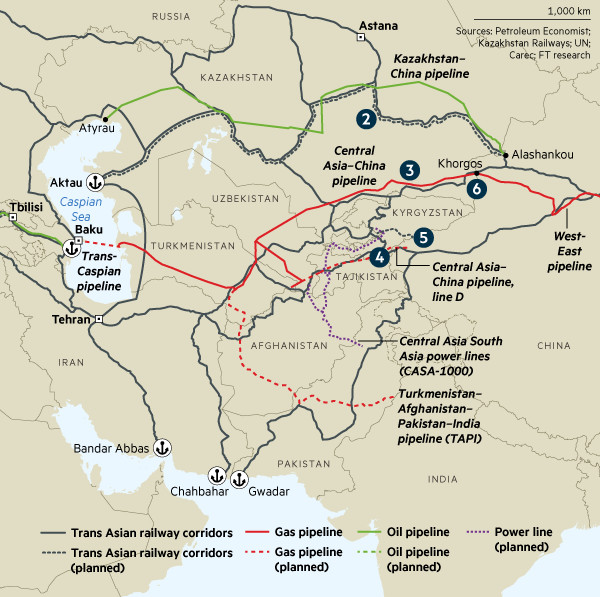China seeking to revive the Silk Road

Roula Khalaf, Editor of the FT, selects her favourite stories in this weekly newsletter.
The ancient trade in silk, spices and slaves between China and Europe turned central Asian oases into wealthy business hubs. Now, with China seeking to rebuild the Silk Road as its signature foreign policy initiative, countries across post-Soviet central Asia, the Caucasus and beyond are hoping China’s westward expansion will once again bring them riches.
The investments “will revitalise economic activity and trade in this part of the world”, says Erlan Idrissov, foreign minister of Kazakhstan.
They are much needed. With falling commodity prices and recession in Russia, growth in central Asia and the Caucasus is set to fall to a two-decade low this year, according to the International Monetary Fund.
“This set of shocks is likely to persist,” says Masood Ahmed, IMF director for the Middle East and Central Asia. “The [new Silk Road] initiative can bring substantial advantages and gains.”
The effects of Beijing’s new “One Belt, One Road” policy, unveiled in 2013, however, remain unclear. Two decades of hefty investments since the break-up of the Soviet Union have already made China the pre-eminent economic power in central Asia.

China’s trade with the region rose from $1.8bn in 2000 to a high of $50bn in 2013, says the IMF. Chinese companies own close to a quarter of Kazakhstan’s oil production and account for well over half of Turkmenistan’s gas exports. China’s state Eximbank is the largest single creditor to impoverished Tajikistan and Kyrgyzstan, respectively holding 49 and 36 per cent of their government debt.
Officials have seen a rush from Chinese bureaucrats and businessmen eager to brand projects as part of the new Silk Road. Initial discussions have focused on infrastructure and exporting overcapacity in China’s industrial sector — sometimes by literally moving unneeded factories and equipment.
Gulmira Isayeva, Kazakhstan’s deputy agriculture minister, says Chinese companies are in negotiations to invest $1.9bn into Kazakh agriculture — including one project that would see the relocation of tomato processing plants from China to the Kazakh steppe.
New trade routes are opening, with rail commerce between China and Europe more than doubling last year.
While Beijing insists its Silk Road plans are not a geopolitical gambit, some parties are wary of China expanding its economic presence. The creation of financial architecture to fund “One Belt, One Road” — including the $40bn Silk Road Fund and the $100bn Asian Infrastructure Investment Bank — met resistance from Washington and Tokyo. From Russia, which is promoting its own integration project, the Eurasian Economic Union, China’s plans received a cold reception and were “perceived as ‘they’re trying to steal central Asia from us,’” says Alexander Gabuev at the Carnegie Moscow Centre think-tank.
A combination of careful Chinese diplomacy and Moscow’s economic woes led to an agreement in May 2015 to “co-ordinate” the projects. The AIIB will work with the Washington-led World Bank and Tokyo-led Asian Development Bank on many investments.
“Two years ago people were saying this is an imperialistic move,” says Agris Preimanis, central Asia economist at the European Bank for Reconstruction and Development. “Now, partly thanks to the way the Chinese have played it, partly because of the economic situation, it is shaping up.”
Some concerns remain as China’s influence grows. In a recent outburst, leaked online, China’s ambassador to Astana, Zhang Hanhui, upbraided Kazakhstan over visas difficulties faced by diplomats’ families “[China] is the second-largest economy in the world,” he said. “Like it or not, favourable conditions should be created.”
Local people are suspicious of China’s motives. Protests broke out in several provincial towns in Kazakhstan in April over a new land code and fears that the government could sell off land to China.
Others worry that the new Silk Road is simply a subsidy for Chinese companies and that local people will see little benefit. Corruption is rife in the region and Chinese projects have been no exception. In April, a scandal over the allocation of a road-building contract to a Chinese company led to the resignation of the Kyrgyz prime minister.
“Chinese money will definitely boost us,” says one Kazakh executive. “It is beautiful. But who will get the benefit? The man in the street or someone in power?”
Selected infrastructure projects

1) Moscow-Kazan high-speed railway A China-led consortium last year won a $375m contract to build a 770km high-speed railway line between Moscow and Kazan. Total investment in the project — set to cut journey time between the cities from 12 hours to 3.5 hours — is some $16.7bn.
2) Khorgos-Aktau railway In May last year, Kazakhstan’s President Nursultan Nazarbayev announced a plan to build — with China — a railway from Khorgos on the Chinese border to the Caspian Sea port of Aktau. The scheme dovetails with a $2.7bn Kazakh project to modernise its locomotives and freight and passenger cars and repair 450 miles of rail.

3) Central Asia-China gas pipeline The 3,666km Central Asia-China gas pipeline predated the new Silk Road but forms the backbone of infrastructure connections between Turkmenistan and China. Chinese-built, it runs from the Turkmenistan/Uzbekistan border to Jingbian in China and cost $7.3bn.
4) Cental Asia-China gas pipeline, line D China signed agreements with Uzbekistan, Tajikistan and Kyrgyzstan to build a fourth line of the central Asia-China gas pipeline in September 2013. Line D is expected to raise Turkmenistan’s gas export capacity to China from 55bn cu m per year to 85bn cu m.
5) China-Kyrgyzstan-Uzbekistan railway Kyrgyzstan’s prime minister Temir Sariev said in December that the construction of the delayed Kyrgyz leg of the China-Kyrgyzstan-Uzbekistan railway would start this year. In September, Uzbekistan said it had finished 104km of the 129km Uzbek stretch of the railway.
6) Khorgos Gateway Khorgos Gateway, a dry port on the China-Kazakh border that is seen as a key cargo hub on the new Silk Road, began operations in August. China’s Jiangsu province has agreed to invest more than $600m over five years to build logistics and industrial zones around Khorgos.
Comments